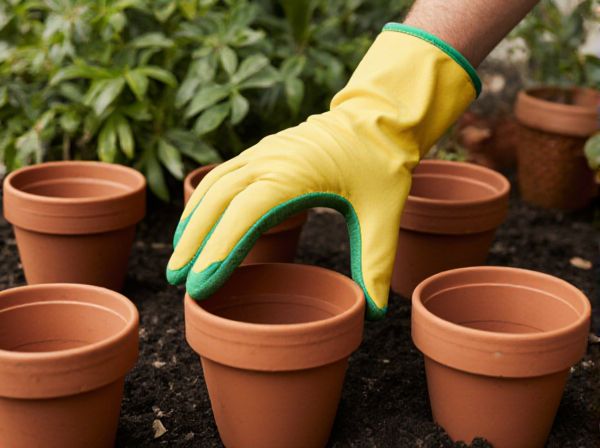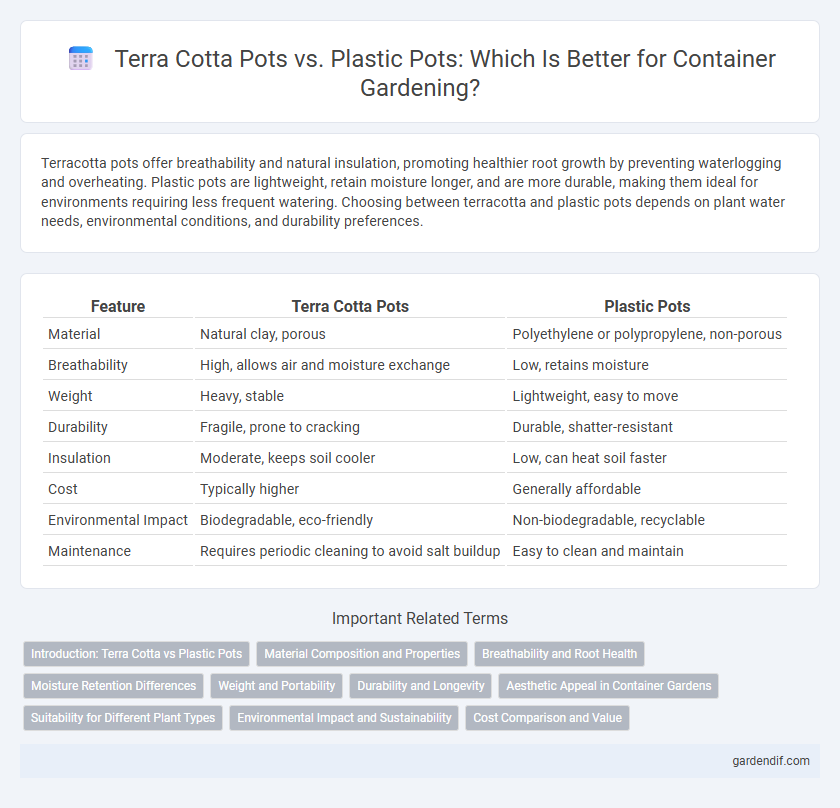
Terra cotta pots vs Plastic pots Illustration
Terracotta pots offer breathability and natural insulation, promoting healthier root growth by preventing waterlogging and overheating. Plastic pots are lightweight, retain moisture longer, and are more durable, making them ideal for environments requiring less frequent watering. Choosing between terracotta and plastic pots depends on plant water needs, environmental conditions, and durability preferences.
Table of Comparison
| Feature | Terra Cotta Pots | Plastic Pots |
|---|---|---|
| Material | Natural clay, porous | Polyethylene or polypropylene, non-porous |
| Breathability | High, allows air and moisture exchange | Low, retains moisture |
| Weight | Heavy, stable | Lightweight, easy to move |
| Durability | Fragile, prone to cracking | Durable, shatter-resistant |
| Insulation | Moderate, keeps soil cooler | Low, can heat soil faster |
| Cost | Typically higher | Generally affordable |
| Environmental Impact | Biodegradable, eco-friendly | Non-biodegradable, recyclable |
| Maintenance | Requires periodic cleaning to avoid salt buildup | Easy to clean and maintain |
Introduction: Terra Cotta vs Plastic Pots
Terra cotta pots are made from porous clay, allowing air and moisture to pass through the walls, which benefits root aeration and prevents overwatering. Plastic pots are lightweight, durable, and retain moisture longer, making them ideal for plants requiring consistent hydration. Choosing between terra cotta and plastic depends on factors like plant type, watering frequency, and environmental conditions.
Material Composition and Properties
Terra cotta pots are made from natural clay that is porous, allowing for better air and water circulation, which promotes healthier root growth and prevents overwatering. Plastic pots are composed of lightweight, non-porous polymers such as polyethylene or polypropylene, offering durability and moisture retention but limited breathability. The thermal properties of terra cotta help regulate soil temperature, while plastic pots tend to retain heat, potentially stressing plant roots in hot climates.
Breathability and Root Health
Terracotta pots offer superior breathability due to their porous nature, allowing air and moisture to circulate through the walls, which prevents root rot and promotes healthier root systems. In contrast, plastic pots lack this natural ventilation, often leading to water retention and anaerobic soil conditions that can harm roots. Choosing breathable terracotta containers supports optimal root oxygenation and overall plant vitality.
Moisture Retention Differences
Terracotta pots are porous, enabling air and moisture to pass through their walls, which promotes better drainage but causes faster drying of the soil. Plastic pots are non-porous, retaining moisture longer by preventing water evaporation and reducing the frequency of watering. For plants requiring consistent moisture levels, plastic containers offer superior moisture retention compared to terracotta pots.
Weight and Portability
Terra cotta pots are heavier and less portable due to their dense, porous clay material, making them ideal for stable, permanent placements. Plastic pots weigh significantly less, enhancing portability and ease of movement, which benefits gardeners who frequently rearrange plants or transport containers. The lightweight nature of plastic also reduces strain during handling, favoring users with mobility concerns or outdoor setups requiring regular adjustments.
Durability and Longevity
Terra cotta pots offer natural breathability that reduces root rot, yet they are prone to cracking under extreme weather conditions, limiting their durability. Plastic pots provide superior resistance to impact, weather, and UV exposure, ensuring longer longevity in various environments. Choosing between the two depends on balancing the natural aesthetic and moderate durability of terra cotta with the robust, long-lasting qualities of plastic containers.
Aesthetic Appeal in Container Gardens
Terra cotta pots offer a classic, earthy aesthetic with their warm, natural hues and textured surfaces, enhancing the visual appeal of container gardens by complementing greenery and flowers. Plastic pots, while available in various colors and styles, often lack the rustic charm and timeless elegance that terra cotta provides. The porous nature of terra cotta also adds subtle weathering effects over time, creating a more organic and dynamic look compared to the uniform finish of plastic containers.
Suitability for Different Plant Types
Terra cotta pots provide excellent breathability and moisture regulation, making them ideal for succulents, cacti, and Mediterranean herbs that prefer dry conditions. Plastic pots retain moisture longer and are better suited for moisture-loving plants like ferns, tropical species, and vegetables requiring consistent hydration. Selecting the right container based on plant water needs enhances root health and overall growth performance.
Environmental Impact and Sustainability
Terracotta pots are biodegradable and made from natural clay, offering eco-friendly disposal and minimal environmental impact compared to plastic pots, which contribute to long-term pollution due to their non-biodegradable nature. The production of terracotta involves lower energy consumption and fewer harmful emissions than plastic manufacturing, enhancing sustainability in container gardening. However, plastic pots offer durability and reusability, potentially reducing the frequency of replacement, but their environmental cost remains higher due to reliance on fossil fuels and landfill accumulation.
Cost Comparison and Value
Terra cotta pots typically have a higher initial cost compared to plastic pots due to their handcrafted nature and natural materials, but they offer better breathability and aesthetic appeal, which can enhance plant health and home decor value. Plastic pots are more cost-effective, lightweight, and durable, making them ideal for large-scale gardening or frequent relocation, though they may degrade over time and lack the natural insulation of terra cotta. When evaluating cost versus value, terra cotta pots provide long-term benefits in plant growth and visual appeal, while plastic pots prioritize affordability and practicality.
Terra cotta pots vs Plastic pots Infographic

 gardendif.com
gardendif.com